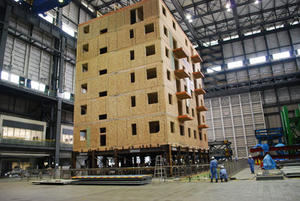EarthquakesCalifornia quake test shows promise of new building code
Researchers place a model hospital on a shake table to assess the structure’s ability to withstand earthquake; in accordance with California latest building code, base isolators, which are rubber bearings intended to absorb the shock of the motion, were installed underneath the structure; the hospital passed the 6.7-magnitude and 8.8-magnitude tests with flying colors

Building on shake table ready for testing // Source: tamu.edu
Last Tuesday, engineers from the University of California, San Diego conducted an ambitious and successful earthquake simulation, with what some called “boring” results.
Engineered had constructed a 5-story building, complete with a hospital operating room, an elevator, a kitchen filled with glassware. They also added a heavy air-conditioning unit to the roof. The building, built to California’s top earthquake codes, was then placed on top of a shake table, a device for shaking structural models or building components with a wide range of simulated ground motions, including reproductions of recorded earthquake time-histories. Modern shake tables typically consist of a rectangular platform which is driven in up to six degrees of freedom (DOF) by servo-hydraulic or other types of actuators, allowing motion with acceleration in both horizontal axes as well as a vertical axis.
The New York Times reports that the shake table unleashed a 1-minute equivalent of the 6.7-magnitude Northridge quake which struck Los Angeles in 1994.
The test result was positive, though uneventful. There were no cracks, broken windows, shattered glassware in the kitchen, and the air-conditioning unit remained on the roof. Only the swaying of utility cables indicated that an event was underway.
A second test, conducted a half-hour later, replicated the powerful 8.8-magnitude temblor that struck Chile in 2010, but the impact on the building was hardly different.
The reason for the low impact of the simulated quakes is the installation of base isolators, which are essentially rubber bearings intended to absorb the shock of the motion. California building codes require all new hospitals, schools, and municipal buildings to incorporate base isolators into their design.
At the end of April, the experiment will be repeated, this time without the base isolators. Expectations are that the results will be very different.
